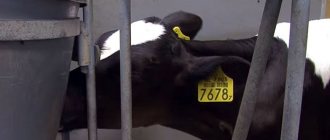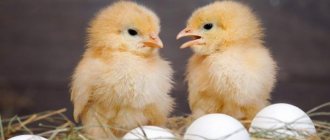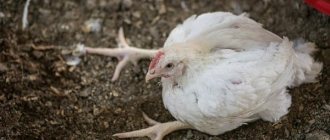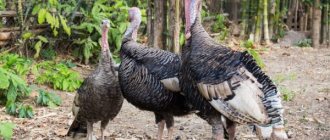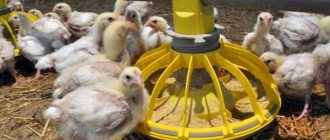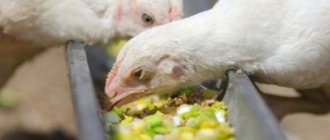Poultry farming » Chickens
3
14359
Article rating
Kira Stoletova
Many farmers face problems when raising poultry. Why do broilers fall on their feet? Why do chickens sit on their feet and die? We will analyze the most famous culprits of the disease and suggest the best ways to get rid of them.
Broilers fall to their feet and sit
Rickets
Vitamin D deficiency is the most common cause and treatment will help get the bird back on its feet. The disease occurs during acute hypovitaminosis and affects both young animals and adults. Disruption of calcium and phosphorus metabolism provokes a deterioration in bone formation, so the chicken falls on its feet. The result is chronic weakening of the limbs, which also leads to deformation of the egg shell.
Rickets develops with a lack of sunlight and then broiler chickens fall on their feet en masse. Vitamin D is the only trace element that is formed in the body under the influence of ultraviolet radiation. Chickens walking outdoors fall on their feet less often than those kept in cages.
The main signs of rickets in chickens:
- decreased appetite;
- ruffled feathers;
- low mobility;
- lack of coordination.
If within three weeks the farmer does not pay attention to the manifestations of the disease, then the condition worsens. Due to a lack of calcium, the beak becomes soft to the touch. The final stage is characterized by complete loss of strength and death of the individual.
If adult chickens begin to lay eggs in soft or fragile shells, then this is a sign of a lack of vitamin D. The disease then affects the legs and bones, as a result of which the bird has difficulty getting up on its feet; broilers often fall. In laying hens, the laying process is disrupted. Therefore, knowing why chickens fall on their feet and how to treat them is the primary task of every breeder.
Features of broilers
Broilers are bred by crossing productive meat varieties. The resulting birds are characterized by rapid formation. Already by 2–3 months, individuals are able to reach their maximum weight. Chickens produce few eggs, and the offspring do not receive the quality of their parents.
Based on the above, broilers have the following features:
- grow quickly;
- require increased nutrition from the first weeks of life;
- they weigh a lot, so they are unable to fly over fences and climb onto high perches;
- With normal care they are not susceptible to disease.
Attention! A chicken can gain 30–80 g per day.
White diarrhea in broilers: treatment and possible causes
A possible cause of frequent, liquid droppings with a whitish tint is salmonella. The infection is very common in poultry and, unfortunately, can affect humans. The disease spreads to chickens from infected chickens, as well as through contact with shared equipment or failure to maintain cleanliness in the poultry house.
When choosing a treatment strategy, in addition to white diarrhea in broilers, about the presence of salmonellosis, pay attention to:
- on the depressed state of the bird;
- to the chicks’ reluctance to move, lethargy;
- developmental lag compared to healthy peers;
- to rapid, labored breathing through an open beak.
In private farmsteads, the causative agent of the disease is fought with the help of sulfonamide drugs
At the same time, it is important to remove sick birds and carefully monitor the well-being of the remaining ones.
A common provocateur of illness is incorrect content
Experts name several main reasons why broilers fall on their feet:
- rickets;
- arthritis;
- infection;
- limb injuries.
Most often the problem occurs due to the fault of the owner. Relying on natural endurance, the owner neglects the needs of the bird. The following errors are common:
- Thickened content. For good development, chickens need to move. If they do not have this opportunity, vitamins and minerals are poorly absorbed, and the functions of organs and joints are impaired.
- Neglect of hygiene rules. If the chicken coop is not cleaned and the feeders and drinkers are not washed, conditions are created for the spread of harmful microorganisms. The broiler falls on its feet due to an infection or poisoning from its own waste products.
- Overly sterile conditions. It happens that the owner shows extreme zeal when cleaning. Frequent washing and cleaning destroys not only harmful, but also beneficial microorganisms.
- Lack of access to clean air. If the coop is poorly ventilated, broilers become vulnerable to disease because their immune defenses are reduced. Also, without ventilation, favorable conditions are created for the development of infections.
- Very low or high temperature in the coop. Cold and heat are dangerous for chickens, but an adult chicken also begins to get sick if it is constantly hypothermic or overheated.
- Lack of sunlight. To absorb calcium, broilers need vitamin D, which is not formed in the absence of ultraviolet radiation. The broiler falls over as its bones and joints weaken.
- Improper arrangement of perches. If the perches are located high, birds will be injured when trying to jump off the crossbar or climb into the roosting area.
Why do broilers sit on their feet?
Leg problems are common in both small broilers and adults. True, there are many reasons for their development, so before treating the bird, it is worth understanding the root cause of what happened.
Unacceptable conditions of detention
Violation of sanitary and hygienic standards for keeping broilers is not the only one, but one of the first “suspects” when chickens’ legs fail.
The main criteria that allow us to evaluate that very “norm” include:
- Bird stocking density should be no more than 5 birds per 1 sq. m;
- regular cleaning of the poultry house - should be done at least once every few weeks (in a confined space bacteria develop very quickly, which leads to the appearance of various ailments);
- excessive sterility of the room - frequent cleaning leads to the destruction of beneficial bacteria, which causes the bird’s immunity to suffer and its natural microflora to be disrupted;
- ignoring the beginning of the problem - if there are already several broilers in the chicken coop with “moving legs”, they cannot be left together with healthy individuals;
- violation of the rules for arranging ventilation and fresh air flow - high humidity and stagnant air are an excellent “soil” for the development of pathogenic microorganisms;
- unsanitary feeders and drinkers - normally they need to be cleaned at least once every few days, especially if the birds are given wet mash.
Usually changes in conditions of detention are enough to localize the problem in its initial stages of development and avoid more serious consequences. However, if leg ailments in adult broilers or chickens are widespread, then it is worth considering other possible reasons for their development.
Did you know? In fact, chickens are not as stupid as many people think. From the first hours of their life they can count, and the general level of development of chicks is much higher than that of a one-year-old human baby.
Avitaminosis
For both humans and animals, a complete and properly balanced diet, with a sufficient amount of vitamins and minerals, plays a significant role in good health. If they are deficient, they speak of vitamin deficiency, which in the case of broilers most often appears on those farms where the birds are fed exclusively with feed mixtures.
For the full growth and development of young animals and high productivity of adults, they simply need greens, as well as raw and boiled vegetables (for example, cabbage, beets, zucchini and carrots).
In the absence of these products, veterinarians advise using ready-made vitamin and mineral formulations. Starting from the age of five days, it is useful for chickens to be given preparations containing vitamins A, D and E, which are either mixed with food or dropped dropwise into the chicks’ mouths.
If you decide to replenish your birds’ vitamin reserves with natural products, then you should pay attention to sprouted grains and seasonal greens. The rate of distribution of such food is not limited, the main thing is that no poisonous specimens are found in the collection of herbs.
Maintaining an optimal ratio of vitamins and minerals in the body is an excellent prevention of mortality in broilers.
Important! An excess of nutrients is just as harmful as a shortage, so if you decide to give your bird ready-made veterinary medications, be sure to follow the instructions exactly.
Possible diseases
Violation of sanitary and hygienic standards when keeping poultry and ignoring its needs for nutritional components, of course, create excellent conditions for the development of illnesses, but the development of infectious and bacterial processes in the body will bring much more harm.
Many of them are characterized by failure of the legs, but among the most common causes of death, the following are worth highlighting.
Rickets
Unlike other diseases, rickets most often manifests itself in young chickens and is explained by a lack of vitamin D in the body. However, one should not exclude the possibility of its occurrence in adult chickens, especially if they have been kept in inappropriate conditions since childhood.
Disruption of metabolic processes in the body and a decrease in calcium concentration lead to a deterioration in the formation of bone tissue, which is why broilers have weak legs. If the bird is kept only in enclosed spaces with limited exposure to sunlight, signs of rickets are observed in almost all representatives of the chicken flock.
Do not forget that the mentioned vitamin D is the only trace element, the formation of which occurs in the body exclusively under the influence of ultraviolet radiation, therefore chickens that spend more time in the fresh air are much less likely to experience changes in bone tissue, which means that leg problems are reduced to a minimum.
As for the main symptoms of rickets in broilers, these include:
- disheveled appearance and dull plumage;
- limited mobility;
- decreased appetite;
- impaired coordination of movements;
- softening of beak and claws;
- decline and death.
If for several weeks the owner did nothing to prevent the further development of the disease, then the condition of the birds will worsen every day, until the death of the sick bird.
Newcastle disease
Newcastle disease is rightfully considered one of the most dangerous viral diseases of poultry, because the percentage of fatal cases is very high. Infection of healthy individuals occurs both through direct contact with a sick bird and as a result of the sharing of feeders and drinkers.
The incubation period is usually 7–12 days, but weak individuals may die within the first day after infection.
You can notice the development of the disease (if it does not occur in a latent form) by the following signs:
- loss of coordination, paralysis of the limbs and neck;
- loss of appetite, diarrhea;
- mucus discharge from the nose and beak, coughing, hawking;
- the appearance of vision problems (usually conjunctivitis and blurred eyes);
- increased body temperature;
- sedentary and depressed state.
In some cases, Newcastle disease takes a chronic form and manifests itself in:
- limited mobility;
- the appearance of cramps in the limbs and cervical region;
- loss of appetite and general exhaustion of the body;
- overexcitation of the nervous system, expressed in shaking or twitching of the head.
In the latter case, the chances of saving broilers are greater and with adequate treatment it will be possible to reduce the probability of death to 15–30%.
Important! Newcastle disease can affect any type of poultry, so broilers are often infected through contact with ducks, geese or turkeys while walking together.
Pullorosis
This disease is of infectious origin and is more typical for young broilers. Among the main reasons for the development of the disease are poor nutrition of poultry and violation of sanitary and hygienic standards for its maintenance, which only contributes to the spread of the pathogen - the bacterium Bacillus pullorum.
The main symptoms of pullorosis in chickens are:
- sedentary lifestyle due to weakness in the legs;
- constantly closed eyes;
- frequent breathing only through the beak (so it is open all the time);
- white diarrhea;
- exhaustion of the body;
- constant feeling of thirst.
Of course, when sick individuals are identified, they must be immediately isolated from healthy livestock, and the room, feeders and drinking bowls must be treated with disinfectants. For the treatment of pullorosis in broilers, Biomycin is usually prescribed with the addition of Furazolidone to the feed mixtures.
For preventive purposes, it is recommended to ventilate the poultry house more often and carry out its sanitary treatment in a timely manner.
Marek's disease
Another dangerous disease of an infectious nature, which is characterized by damage to the nervous system and eyes of broilers.
The incubation period has a fairly wide range and can last from several weeks to 150 days (the specific time for the development of the disease depends on the age of the birds, their health status and the individual characteristics of the immune system).
The characteristic symptoms of Marek's disease are mostly determined by the form of its course (acute or classic), but almost always the list of main symptoms includes the following:
- disorientation in space, which leads to constant falls and injury to sick individuals;
- loss of appetite and rapid exhaustion of the body;
- constriction of the pupil and changes in the iris;
- pale growths on the head;
- weakening of motor activity;
- decrease and complete loss of vision (the bird simply stands in one place or constantly falls to the side when moving).
Unfortunately, there is still no effective treatment for Marek's disease, and the only effective method is prevention with the timely use of a suitable vaccine.
Did you know? Images of chickens were found during excavations of Tutankhamun's tomb, which means that people knew, and possibly bred, them as early as 1350 BC. e.
In the initial stages of the development of the disease, before the bird begins to fall on its feet, the drug Acyclovir can sometimes be used as antiviral therapy, but even in this case, the 100% effectiveness of such treatment cannot be guaranteed.
Coccidiosis
A bacterial disease that mainly affects young broilers up to three months of age. The cause of the disease can be one of eleven possible types of pathogenic bacteria that enter the body of a healthy bird along with the secretions of a sick bird (if kept together) or through insect bites.
Sometimes the carrier of coccidiosis is the person himself, who uses equipment and clothing that have not been treated after contact with a sick bird.
It is very difficult to determine the exact time of the incubation period, since in each individual case the duration of the “hidden” phase is different, and only when the bacteria have already firmly settled in the body of the birds, the following symptoms become noticeable:
- lethargy, depression and apathy (chickens may refuse to leave their roosts);
- lack of appetite and, as a result, weakening of the body due to lack of nutrients;
- lack of coordination;
- diarrhea mixed with blood;
- constant presence near a heat source (more typical for small chickens, which constantly feel cold due to exposure to bacteria).
The fastest and most effective way to determine the presence of coccidiosis is to examine dead birds in the laboratory. When the diagnosis is confirmed and the first signs of illness are present in surviving birds, they are prescribed complex medications, for example, Baycox or Amprolium.
Aspergillosis
A disease of fungal origin that affects the respiratory system mainly of young broilers. Most often, poultry infection occurs through the consumption of contaminated feed, the use of straw or other bedding material, and the development of the disease can be observed at any time of the year.
Aspergillosis is considered one of the most dangerous diseases, characterized by such manifestations as:
- apathetic and lethargic state;
- hoarseness;
- decreased or complete lack of appetite;
- rapid and difficult breathing;
- growth retardation.
In the acute form of the disease, the probability of death among young individuals reaches 80–100%.
The chronic form is more typical for adult broilers and is manifested by the death of embryos, cessation of egg laying and general depletion of the chicken’s body. Sometimes mucous discharge from the eyes and nose is observed. If detected early, aspergillosis can be treated with antibiotics.
Arthritis
Unlike most previous options, arthritis is one of those diseases that is more typical for adult broilers.
Find out what chicken leg diseases exist and how to treat them.
The main symptom is lameness and loss of legs, which is explained by the development of the inflammatory process in the joint capsules and adjacent soft tissues.
In addition, swelling and increased temperature of the joints are often observed, and if the problem is ignored for a long time, all changes in the body of chickens become irreversible, that is, the bird will never be able to walk again.
Important! An early sign of the development of arthritis is the inability of a chicken to stay on the perch, so if a chicken constantly stays away and does not try to fly to the perch, you should suspect problems with its legs.
There are frequent cases of death, and this applies to both adults and young animals.
The link between disease and nutrition
Many farmers rely on the fact that complex feed contains all the elements necessary for poultry. Monotonous feeding often leads to broilers sitting down or falling on their hind legs. In addition to using a limited diet, the owner often makes the following mistakes:
- Feeds chickens the same as adult broilers. The first time after birth, chickens are unable to digest certain types of food, so they begin to get sick and die.
- Abuses food additives.
- Doesn't follow the diet. Chickens should not be fed only once a day or every hour. This causes obesity or exhaustion of the body.
- Does not change the diet with the onset of cold weather. In winter, birds have an increased need for fat; it is necessary to increase the amount of vegetables, since broilers cannot get fresh grass.
- Does not pay attention to sources of calcium.
- Gives chickens food that shows signs of spoilage. Birds run the risk of becoming infected through their feed.
- Mixes food that has stagnated in the feeders with fresh food.
Feed additive for chickens
To prevent falling on your feet, you should try dry feed acidifier “Vitacid”. The drug was developed taking into account the physiological characteristics of the bird. It exhibits high antimicrobial activity. An antibacterial effect is achieved by lowering the pH. This creates an environment in which pathogenic bacteria are unable to develop.
Premixes
In order for the livestock to grow quickly, without diseases of the musculoskeletal and other systems, you need to choose the right feed with a balanced content of proteins, fats, carbohydrates, minerals, and microelements. Specially developed premixes for chickens of different breeds and ages (broilers, layers, young animals, adults).
Premixes: what is a premix and what is its benefit, premixes for pigs: (read more)
The premix for each age contains the components, vitamins, and minerals necessary for the growing body. To avoid chicks falling on their feet, it is worth ordering a suitable type of premix (mineral, vitamin, protein or complex).
Infections are the most dangerous factor
There are a number of infections that cause illness. Birds most often acquire harmful microorganisms from infected birds. Infections affect broilers with a weakened or fragile body. Possible problems:
- Newcastle disease;
- pullorosis;
- Marek's disease;
- coccidiosis;
- aspergillosis.
The listed diseases have other symptoms in addition to weakening of the limbs. The most common are: diarrhea, lack of appetite, loss of coordination, blurred vision, lethargy. As a rule, if the problem is infectious, the broiler’s condition quickly deteriorates, so it is necessary to call a specialist to help the bird.
How to recognize a problem at an early stage?
It is important to identify a problem in the condition of broilers at the very beginning; sometimes early diagnosis prevents complete loss of livestock. In the initial period of most pathologies, you can eat meat.
If you notice that the chickens have begun to limp, their gait has changed, and has become uncertain, you should immediately pay attention to the conditions in which the birds are kept. If there are no problems, the house should be checked for signs of disease.
Be sure to read:
How to get rid of chicken lice using folk and chemical means
The paws and the entire body should be examined. They also look into the mouths of broiler chickens. The presence of foam in the throat is a sign of dangerous pulmonary pathologies.
Treatment options depending on the cause
If a broiler falls on its feet, the owner should evaluate the possible causes of the problem. Most often, to eliminate the disease, it is enough to correct the flaws in maintenance and nutrition. However, to prevent the death of the entire livestock, it is necessary to consult a veterinarian. A specialist will help rule out a viral or bacterial cause of the disease.
If the non-infectious nature of the problem is confirmed, treatment is as follows:
- adjusting the diet of broilers, enriching food with calcium and sources of vitamins;
- inclusion of grass and sprouted grains in the daily poultry menu;
- elimination of possible sources of food contamination (timely cleaning of the chicken coop, cleaning of feeders);
- insulation of the poultry house during the cold period;
- moving perches closer to the floor.
If chickens develop rickets, it is recommended to treat them with fish oil, tricalcium phosphate, and vitamin D3. Calcium and phosphorus supplements are given at the rate of 2% of the total food daily. The owner must also provide the chickens with free range and access to sunlight. In winter, the lack of ultraviolet radiation is compensated with special lamps.
Arthritis is treated with ampicillin. The dosage is calculated depending on the weight of the broiler. For 1 kg of bird weight, about 20 mg of medication is required.
Attention! The appropriateness of using the drug and the duration of therapy should be determined by a veterinarian.
If the development of a serious infection is suspected, the condition of the broilers is assessed and the possibility of treatment is carried out. If the disease is advanced, it is recommended to eliminate the affected bird to reduce the risk of infection to other inhabitants of the poultry house. General treatment tactics:
- isolation of sick chickens;
- ensuring normal nutrition;
- prescription of antiviral drugs and antibiotics.
The medicine is selected depending on the identified ailment. Giving the drug on your own is dangerous, since the wrong decision will lead to the death of the bird. This issue should be left to a professional.
Preventive measures
To prevent problems from arising, it is better to prepare for them in advance. Preventive measures can not only save you from trouble, but also save the entire livestock. We recommend reviewing the diet and adding components necessary for broilers. Proper nutrition from childhood is the key to the health of adults.
If the culprit of the disease is a violation of maintenance, then the problem must be eliminated immediately. Remember that metabolic processes in a bird’s body occur very quickly. Ignoring the requirements will lead to the death of the entire herd.
Egg breeds of chickens require a lot of living space. If there is movement, then obesity can be avoided. Crowding is always dangerous: due to close housing, viruses quickly spread throughout the chicken coop, which causes mass mortality.
Prevention of pathology
Prevention of diseases consists of observing the conditions in which broilers are kept. These include:
- density of birds – 3 units. per 1 m2;
- cleaning the chicken coop from feces every 7 - 14 days, changing the litter at least once a month;
- removing uneaten food 30 minutes after serving;
- ensuring the air temperature in the chicken coop is not lower than 20 degrees (for chickens in the first week of life - +27 - +30);
- elimination of drafts, arrangement of high-quality ventilation of the room in which broilers live;
- ensuring a good diet from the first days of life;
- timely isolation of birds with signs of illness;
- arrangement of a walking area;
- placement of perches at a level of 60 - 80 cm from the floor.
Often a broiler falls on its feet due to the carelessness of the owner. The problem can be eliminated if the mistakes made are quickly corrected. However, it is best to provide the bird with the correct living conditions from the first days of life.
Description of the problem
Broiler chickens begin to limp and walk poorly. It happens that a broiler falls on its feet or falls on its side and cannot get up. When trying to stand up, the paws move apart.
They lose their appetite and become restless. After numerous attempts, the chickens sit down and lead an inactive lifestyle. Often the condition is accompanied by a deterioration in appetite and problems with plumage.
All problems begin due to dysfunction of the musculoskeletal system. But the reasons are different: legs fail due to infectious diseases, injuries and due to living conditions that affect the health of the birds. In any case, proper treatment is necessary, otherwise the chickens will die.
How to clean a poultry house
Before moving into the chicken coop, you need to whitewash its walls, carefully fill all the cracks, and install double-glazed windows. If the floor is clay or soil, then you need to remove the top 15-20 cm and fill it with new soil. Birds spend a lot of time outdoors. It is at these moments that it is worth cleaning the room:
- To prevent diseases, a solution is prepared: 3% baking soda, 10% sodium, 3% limestone. 1 liter is sprayed onto 1 “square” of the room. heated mixture. Another solution: wood ash and water in a ratio of 1 to 10. Let it brew for a day, strain, and use it in the same proportion;
- After each treatment of the poultry house, you need to thoroughly wash all equipment, drinkers and feeders, and wash off solutions from all metal elements in the room. Then carry out ventilation;
- If the old litter becomes dirty, replace it with a new one. It can be wood ash, chaff, straw, sawdust, grass, peat, ground cereal stalks. They must be thoroughly dried before laying. Chop the straw to lengths of 5 cm, you need to choose only clean straw with a good smell.
Prevention of disease in chickens
The experience of broiler owners shows that it is easier to prevent diseases than to cure them for a long time without guarantees. Prevention begins from the first day of life of broilers. Organizing the life of poultry is a farmer’s primary task. Spacious rooms and cages, access to fresh sun, quality control of food, feed and care that chickens cannot ask for on their own. Chicks are susceptible and weak from birth, and their entire immunity consists of what they eat and drink. Veterinarians say all poultry's problems lie in its feeder. If there are any changes in the well-being of broilers, the approach to food selection should be reconsidered. Chickens need nutrients, calcium and vitamins, which are contained in feed or plants (complementary feeding).
Prevention is not complete without cleanliness of the premises and cages where birds live. Dirt and animal feces are an ideal environment for the proliferation of pathogenic bacteria and microorganisms. In a clean cage, nothing threatens the broiler's body. From the fifth day, it is allowed to add vitamins A and E to the chicken’s feed (they strengthen the chick’s immunity and accelerate its growth and development).
Taking action at random is a luxury a farmer or brood owner cannot afford. A person who has decided to breed poultry should make sure that it is correct and learn to bear responsibility for the birds, no matter what associated problems arise with chickens or broilers during their growth.
Materials taken from the source: villaved.ru


